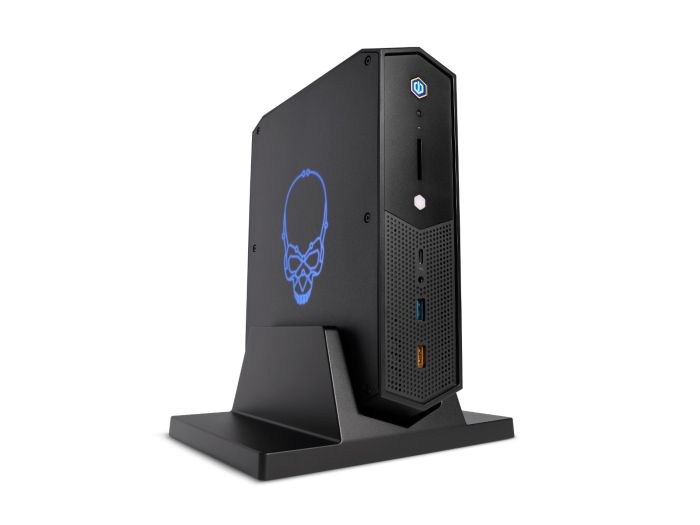Intel has been making small form factor (SFF) PCs for a long time, but the NUC 12 Serpent Canyon is the first one to feature its own discrete graphics card, the Intel Arc A770M. This GPU is based on the Xe HPG architecture, which promises to deliver high-performance gaming and ray tracing capabilities. The NUC 12 Serpent Canyon also comes with a powerful Intel Core i7-12700H processor, which has 14 cores and 20 threads, and supports up to 64 GB of DDR4-3200 memory and three M.2 SSDs. But how does this tiny PC perform in real-world scenarios, and is it worth the premium price tag? Let’s find out in this review.

Design and Features
The NUC 12 Serpent Canyon has a sleek and minimalist design, with a matte black metal chassis and a silver trim. It measures 9.1 by 2.4 by 7.1 inches (HWD), and weighs about 3.5 pounds. It has a case volume of just 2.5 liters, making it one of the smallest gaming PCs on the market. It can be placed horizontally or vertically, using the included stand. It also has a customizable RGB-backlit logo on the front panel, which can be replaced with a different mask or turned off completely.
The NUC 12 Serpent Canyon has plenty of ports and connectivity options, both on the front and the back. On the front, you’ll find two USB-A 3.2 Gen2 ports, one USB-C 3.2 Gen2 port, a headphone/microphone combo jack, an SD Express card slot, and a power button. On the back, you’ll find two Thunderbolt 4 ports, one HDMI 2.1 port, two DisplayPort 1.4 ports, four USB-A 3.2 Gen2 ports, one USB-C 3.2 Gen2 port, an RJ-45 Ethernet port, an optical audio output, and a DC power input. The NUC 12 Serpent Canyon also has dual-array microphones on the top panel, and supports Wi-Fi 6E and Bluetooth 5.3 wireless connectivity.
The NUC 12 Serpent Canyon comes with a pre-installed Windows 11 Home operating system, as well as a wireless keyboard and mouse combo in the box. It also comes with a three-year warranty from Intel.
Performance
The NUC 12 Serpent Canyon is powered by an Intel Core i7-12700H processor, which has a base frequency of 2.7 GHz and a boost frequency of up to 4.7 GHz. This processor is part of the Intel Alder Lake family, which uses a hybrid architecture that combines high-performance cores (P-cores) and high-efficiency cores (E-cores) to optimize performance and power efficiency. The Core i7-12700H has six P-cores and eight E-cores, for a total of 14 cores and 20 threads. It also has 24 MB of L3 cache and a TDP of 45 watts.
The NUC 12 Serpent Canyon also features an Intel Arc A770M graphics card, which has 32 Xe cores, each containing 128 execution units (EUs), for a total of 4096 EUs or shader cores. The GPU also has 32 ray tracing units (RTUs) for hardware-accelerated ray tracing, and 512 XMX engines for machine learning tasks. The GPU has a base clock of 1800 MHz and a boost clock of up to 2400 MHz. It comes with 16 GB of GDDR6 memory running at 16 Gbps on a 256-bit bus, for a memory bandwidth of 512 GB/s.
The NUC 12 Serpent Canyon supports up to 64 GB of DDR4-3200 memory in two SO-DIMM slots, and up to three M.2 SSDs in three M.2 slots that support PCIe Gen4 or Gen3 x4 interfaces. Our review unit came with 16 GB of RAM and a single Samsung PM9A1 SSD with a capacity of 1 TB.
We tested the NUC 12 Serpent Canyon on various synthetic and gaming benchmarks at different resolutions and settings, using the latest drivers from Intel (version 30.0.100.9955) and Windows updates.
In synthetic benchmarks, the NUC 12 Serpent Canyon showed impressive results, scoring higher than most gaming laptops with similar or higher specs in most tests. It also demonstrated excellent ray tracing performance, beating some desktop GPUs like the Nvidia GeForce RTX 3060 Ti in some cases.

| Synthetic benchmark results | Intel NUC 12 Serpent Canyon | MSI GP76 Leopard (RTX 3070) | Asus ROG Strix G15 Advantage Edition (RX 6800M) | Alienware Aurora R12 (RTX 3060 Ti) |
|---|---|---|---|---|
| Time Spy | 11,122 | 10,221 | 10,019 | 10,599 |
| Time Spy Extreme | 5,390 | 4,881 | 4,772 | 5,005 |
| Port Royal | 6,545 | 5,894 | 4,777 | 6,203 |
| Fire Strike | 27,857 | 25,419 | 24,819 | 25,886 |
| Fire Strike Extreme | 15,629 | 14,128 | 13,657 | 14,367 |
| Fire Strike Ultra | 8,339 | 7,388 | 7,063 | 7,692 |
In gaming benchmarks, however, the NUC 12 Serpent Canyon showed some inconsistency. In some modern games that use DirectX 12 or Vulkan APIs, such as Cyberpunk 2077, Doom Eternal, and Red Dead Redemption 2, the NUC 12 Serpent Canyon performed very well, delivering smooth and playable frame rates at both 1080p and 1440p resolutions, with or without ray tracing. It also matched or surpassed some gaming laptops with more powerful GPUs like the Nvidia GeForce RTX 3070 or the AMD Radeon RX 6800M in some cases.
| Gaming benchmark results (fps) | Intel NUC 12 Serpent Canyon | MSI GP76 Leopard (RTX 3070) | Asus ROG Strix G15 Advantage Edition (RX 6800M) |
|---|---|---|---|
| Cyberpunk 2077 (1080p, Ultra, RT off) | 64 | 62 | 60 |
| Cyberpunk 2077 (1080p, Ultra, RT on) | 41 | 40 | 26 |
| Cyberpunk 2077 (1440p, High, RT off) | 51 | 49 | 48 |
| Cyberpunk 2077 (1440p, High, RT on) | 30 | 29 | 19 |
| Doom Eternal (1080p, Ultra Nightmare) | 228 | 224 | 221 |
| Doom Eternal (1440p, Ultra Nightmare) | 159 | 155 | 152 |
| Red Dead Redemption 2 (1080p, Ultra) | 67 | 65 | 64 |
| Red Dead Redemption 2 (1440p, High) | 61 | 59 | 58 |
However, in some older games that use DirectX 11 or lower APIs, such as GTA V, The Witcher 3, and Far Cry 5, the NUC 12 Serpent Canyon struggled to keep up with the competition, falling behind the gaming laptops by a noticeable margin. It also failed to run some games at all, such as Assassin’s Creed Valhalla, Horizon Zero Dawn, and Control, due to driver issues or compatibility problems.